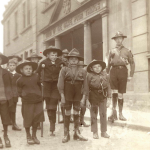In 2013, the University of the Third Age (U3A) carried out a study in collaboration with Langdon Down Museum “to augment its historical database on how Normansfield operated and the people it cared for.” History of Place has been granted permission through the generosity of U3A and Langdon Down Museum to reproduce some of the results of that research. This is the second case study taken from the early years of Normansfield Hospital (1868-1913). The text below is taken directly from the U3A research pages of the Langdon Down Museum of Learning Disability website.
Ref: Case Book H29/NF/B/13/002 pp 122, 137, 138
Robert Belchamber was born and spent his early life in India where his father was working. Before he was 10 years old, his behavior gave cause for concern; he showed “deviation from natural disposition”, disagreed with people he lived with and thought they were listening at his door. His father was away from home for quite some time and Robert became increasingly unmanageable. It was decided, therefore, that he should be brought back to England from Calcutta.
On arrival in England, he was admitted to Normansfield at the age of 17 on the 14 November 1874. When admitted, it was noted that he had abrasions on his wrists where he had been tied up on board ship during the journey. His admission notes state he was average height, but pale and thin. His “bodily functions” were normal except that his circulation was “feeble”. He was not epileptic but he had masturbated (regarded as a contributory factor to mental problems). It was observed that his father was a very nervous man, but no history of insanity was elicited.
When admitted, it was noted that (Robert) had abrasions on his wrists where he had been tied up on board ship during the journey
Robert’s subsequent progress at Normansfield was recorded in a series of chronological entries in the Case Book.
Dec 74 Has already become stout in the face – appetite very large. Has disposition to wander about the house.
Apr 75 Has improved in some respects
June 75 Has improved in many ways
Sep 75 Made real progress lately. Less irritable, more conformable to discipline,
Aug 76 Greatly improved
Apr 77 Has been very peculiar lately
July 77 Talks very little and very morose
Oct 77 Is less morose
Jan 78 Has catarrh – kept in bed – medication prescribed – had mist which he liked.
Oct 78 Visited by father from India
Jan 79 Very good physical health.
Aug 79 Much quieter than previously
Dec 79 Is quieter, but less intelligent
1880 (the same)
June 81 Very quiet and amenable to control
Sep 81 Gives no special trouble and is always very happy
Jan 82 Gives very little trouble now
Apr 82 Going on well1883 (the same)
Continued in Case Book H29/NF/B/13/003 pp 361
Dec 83 In very good health
1884 (the same)
May 85 Weighs seven stone thirteen pounds (now 27/28 years old)
May 86 Seven stone ten pounds
July 86 Seven stone seven pounds
Aug 86 Has been rather more trouble than usual
Oct 86 Is rather thin – medication prescribed and to have one egg and a half pint of milk at 11am and 3pm in addition to ordinary diet
3 Nov 86 Has slight cough – temperature normal
22 Nov 86 Is rather better
Dec 86 Weighs seven stone eleven pounds. (the last entry in the Case Book)
Robert was discharged almost a year later, on 25 November 1887 and his condition on release was solely noted in the discharge register as “relieved”.
From the records it is not clear what condition Robert was considered to be suffering from on admission to Normansfield or, indeed, throughout his stay there. The admission register records his mental condition as “imbecile”. It would not appear, from the infrequency of the case notes, that regular checks were carried out by the senior medical staff. It would be very interesting to know if any medication regime was prescribed in this case to control his behaviour as appears possible from changes recorded in this respect.
From the records it is not clear what condition Robert was considered to be suffering from on admission to Normansfield or, indeed, throughout his stay there
In 1884, Robert was reported to be in very good health. Soon after, in May 1885, his weight was recorded as seven stone thirteen pounds – this seems very low for a male of his age, but did not seem to be any cause for concern for more than a year when his diet was eventually supplemented. Even so, the last entry in the case book indicates he was still of low weight.
Ray Elmitt adds:
Sometime after discharge in 1886, Robert Belchamber went to live at Prospect Terrace in Mevagissey as a boarder in the home of Albert and Georgina Kent. He remained with them until at least 1911 by which time he was 53. He was recorded as being an imbecile and with private means.
Here again we see an example of Normansfield failing to live up to its deserved reputation as a centre of excellence in the care of learning disabled people. Robert’s father, distant both physically and emotionally, seems to fit the traditional Victorian patriarchal stereotype, and there is no mention of a mother. It seems therefore more in his own interest to place the responsibility for the care of his son in the hands of someone else, rather than resulting from any real concern for his son’s welfare. This impression is strengthened by the note stating that his father visited his son only once during his time at Normansfield.
Though described in his case notes as an “imbecile,” no evidence is offered for this diagnosis. Rather, they are vague and sporadic and seem more concerned with whether he was conforming to discipline, rather than how he was responding to care. This suggests the staff at Normansfield were more interested in carrying out the wishes of Robert’s father, who paid the bills, rather than offering palliative care to this particular resident. In this sense their actions, though more humane, resemble those of the ship’s crew who bound Robert’s wrists on his journey back from India.
While the case studies of Ida Page and Robert Belchamber do not show Normansfield at its best, the project did uncover some more positive examples of how the hospital benefited some of its later residents, and these will be covered next.









